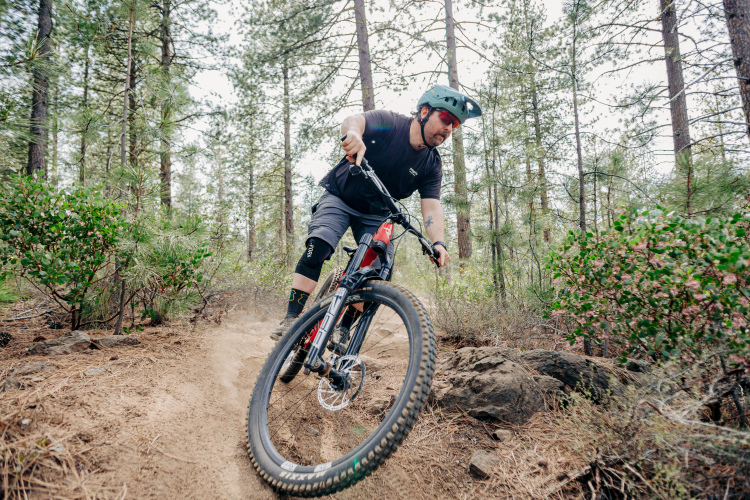
Editor’s note: This is one side of a two-part opinion piece about gravel bikes. Be sure to read the other half here.
Rolling into the hills on low traffic dirt roads and paths is something that many road and mountain bike riders have done for most of our lives. It’s a safer and less stressful way to exercise than riding car-crammed tarmac. The famed RAGBRAI race/ride has been spinning up dust clouds across the state of Iowa since 1973, and Italy’s Strade Bianche has proven an annual showcase of athletic dirt road prowess since 2007. Now we have a specific name and at least two genres of specialty bikes designed to tame the unpaved. Given the history of dirt road riding that dates back before the first Tour de France, is there anything genuinely new about “gravel bikes” or is it simply clever marketing?
When the word gravel first appeared on bike frames, they were largely rebranded cyclocross bikes or hardtail mountain bikes with drop bars. Those frames have morphed over the years, and gravel bikes now have lower bottom brackets, longer wheelbases, and slacker headtube angles than CX frames for added stability and comfort. Many of those frames have also widened their stance to accommodate larger tires for additional grip and cushion, and some offer internal dropper post routing and suspension.
So what sets these new bikes apart from classic XC hardtails with drop bars or cyclocross race bikes?
Singletracks staff writer Matt Miller and I have discussed this topic a few times, and we individually typed up our perspective on the burgeoning genre. For context, Matt recently purchased a new gravel bike, and I ride an older cyclocross bike or hardtail on dirt roads.
I feel that a good portion of the “gravel genre” is just skillful marketing aimed at convincing folks to buy another bike that they likely don’t need. We already had bikes with many of the same characteristics that gravel bikes are being designed around. Anyone with a good cyclocross bike or XC hardtail already has a bike that will perform fantastically on graveled or dirt roads, and they could better spend their new-bike allowance somewhere else. Old steel road frames with spacing for 28mm or wider tires also ride nicely through the countryside.
The difference between a CX frame and that of a race-bred gravel bike is akin to the distinction between a full-sus bike with 150mm of travel being deemed a “trail bike” where a 160mm bike gets the “enduro” tag. Either the CX or gravel bike could be swapped to race cyclocross or dirt roads in nearly the same way. Similarly, a burlier adventure/all-road gravel bike is just a hardtail with drop bars. They are little more than labels.
I can understand why elite racers who compete in events like Crusher in the Tushar, Dirty Kanza, or Grinduro might want a special bike for those events, but the majority of consumers buying gravel bikes are likely not competing in elite-level races that require those unique frame and component nuances. Most of us could enjoy the same roads on our existing XC or ‘cross bikes.
For the adventure biking crowd, who want 2+” tires and suspension on their drop bar bike so they can ride any surface in front of them, well those bikes have been around for a long time. Salsa Cycles, for example, had a stock drop bar mountain bike in its line long before anyone cared to attach the word “gravel” to it. The frame was covered in cage mounts, ready to rip whatever and wherever. It’s not a new or novel notion to throw a curly-bar on a hardtail so you can have more hand positions and improved aerodynamics on long rides. What is new is that some savvy marketing folks saw a way to fabricate a genre and sell us more gear, rather than sticking with the existing “drop bar mountain bike” distinction.
So why should I care that someone made up a new bike genre? The answer is two-fold. One, I work in the bike industry, and people frequently ask me for advice on bike purchases. When friends inquire about gravel bikes, I try to steer them toward a versatile whip that best facilitates their dreamiest adventures. In most cases, the winner is a sweet hardtail that they already own. “Put drop bars and narrower tires on it if you like.” The second reason is that the words we use to describe and market things hold power and influence, and co-opting the word “gravel” as if it were a new phenomenon disregards the history and lived experiences of loads of folks who don’t like riding in traffic. I love change and nuance in life and sport, but not in this way that feels like consumption for consumption’s sake.
Finally, regardless of how I currently feel about the genre, if a gravel bike makes you want to get outside and ride, it’s likely the best bike for you. If you didn’t already own any of the aforementioned options for riding dirt roads, a slightly slackened CX frame with mountain bike tires might just make your goldilocks bed.
Read Matt’s opposite take on gravel bikes here.











9 Comments
Jan 9, 2020
Yes the differences between a gravel bike and a CX bike are small, but they add up to something much larger. I'm not a road cyclist, so when I hop on a CX bike, I really struggle with them because they're designed to be a race bike first and foremost. Gravel bikes to me feel a lot more comfortable generally, and it's the small changes in tires, geometry etc. that make them feel that way and it's helpful to have that pigeon hole to put them in.
Also don't forget that while 'gravel' as a type of riding has been around for a long time, those bikes were typically (poorly) modified road bikes. Over the last few years there have been specific technological innovations that have allowed gravel bikes to be a thing. Things like reliable tubeless tires, disc brakes, geometry, lighter/stronger materials etc.
Jan 10, 2020
Apr 30, 2020
Feb 28, 2020
In the late oughts, cyclocross bikes were getting more and more versatile due to better designs and more tire availability. Gone were the days of bespoke frames, nuances of cantilever brake adjustment, and tubular tires. Disc brakes, tubless tires, and better frame designs allowing for 40mm tires made our cyclocross bikes more fun and versatile, but still tough and racable. Now with gravel bikes coming out, cyclocross bikes are going back to being dedicated race machines with barely sufficient clearance for 32mm tires. So why not buy a gravel bike? Well, gravel bikes are now becoming encumbered with extra braze-ons, low and slack geometry, dropper posts, 2x drive trains, and even suspension. None of that is appropriate for racing. This situation just kinda sucks for people who race cyclocross but want to have a bike thats both racable and rideable (and know that the popularity in gravel events in the oughties is due to the popularity of cross in the oughts.) There's too many things about gravel bikes that make them bad for technical riding in bad conditions.
I think overspecialization is bad for bike companies. If the cross bikes and gravel bikes and / or hardtails in a bike manufactures product line are truly different, then they will have different molds or tube sets for each. Those tooling and development costs need to be amortized over fewer bike sales, which drive up costs for the consumer and for the manufacturer. In addition, you end up with having products that are competing with your own products, and confusing customers. Again there are so many cross bikes that clear 40mm tires, and so many gravel bikes where 40mm is the maximum. That's just dumb. If I were a cycling product manager, I would only manufacture 1 CX/gravel frame and spec it with 700x32 or 40mm tires and 1x for the racers, and 650x50mm tires for the gravel set, which also has the handy side effect of dropping the bottom bracket slightly.
The gravel craze is just a phase. People were tired of road racing for 3-4 hours only to get dropped, so they started racing cyclocross. Then they got tired of driving 3-4 hours to race for 54 minutes. So now they're driving 3-4 hours to race 8 hours on gravel. They're going to get tired of that too. People are always looking for the next thing, thinking its going to revitalize the sport for themselves or for their business. Product managers need to stop trying to stoke the N+1 effect or the race format dujour and focus on their core competencies and drive toward efficiency and delivering the best possible product to consumers, which is usually the most versatile one. There will always be the core market base of folks who ride all the time and won't quit the sport, these people ride enough such that they need to replace their equipment with some frequency. That's the hard market but that's the real one.
Jan 14, 2020
Jan 9, 2020
Yet, someone came to me and said they wanted a bike with "curly-swirly" bars as they say, I couldn't recommend a gravel bike fast enough. They are comfortable on the road, they are comfortable on gravel, they are poised regardless of the conditions. Typically they are geared better, think average Joe and not racer Joe.
Mar 5, 2020
Jan 10, 2020
Jan 14, 2020
fyi the links to matt's article are not working.